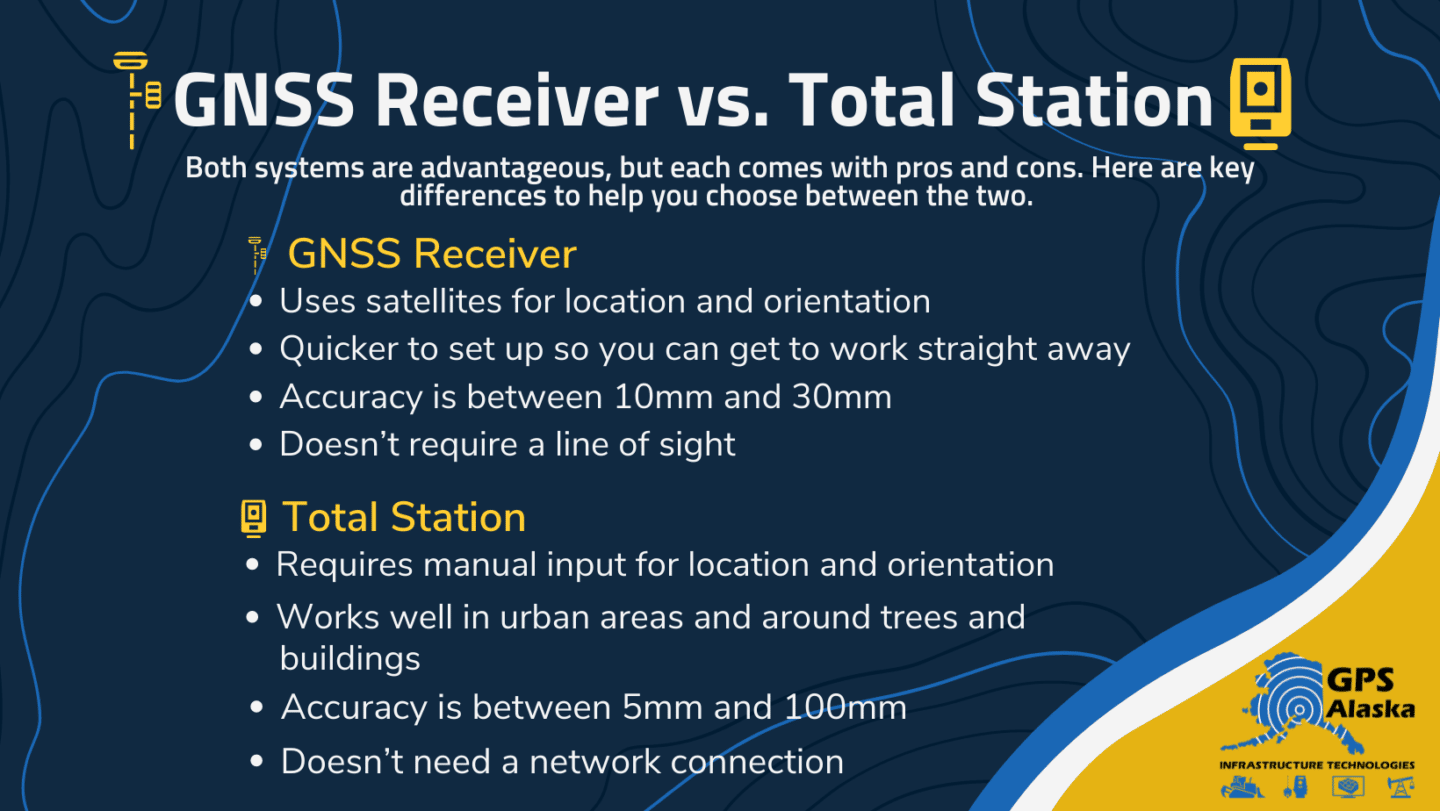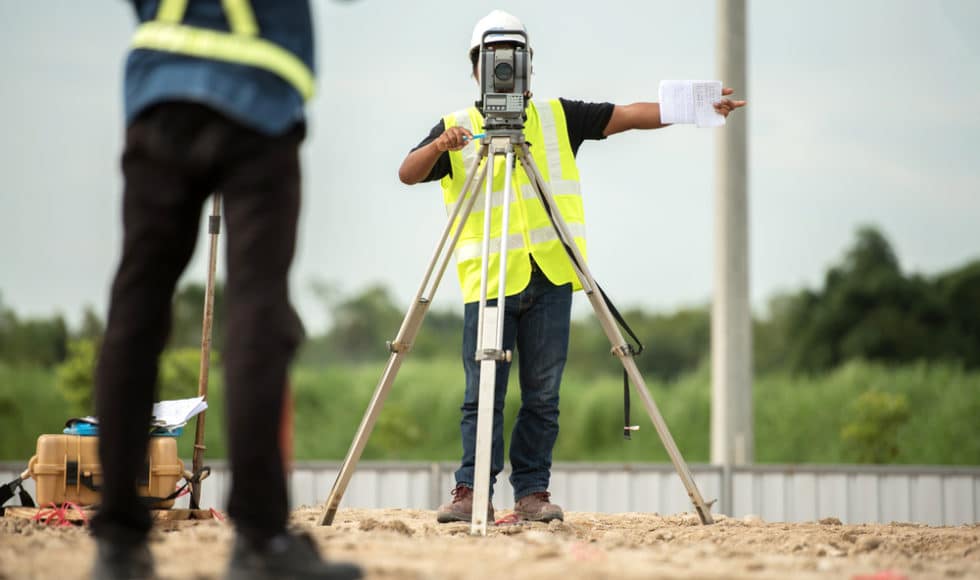Surveying is both an art and a science. In order to make highly accurate, large-scale measurements, you need to have the right tools for the job. As you’re researching, you’ll inevitably come across two distinct systems: GNSS receivers and total stations. Both of these systems can help you analyze an area of land in detail, but they also come with pros and cons. In this blog post, we’ll talk you through some of the main differences between the two to help you decide which one is right for you.
Both of these systems are available at GPS Alaska. Want to talk to an expert? Contact our team.
Comparing GNSS Receivers vs. Total Station Systems

Surveying techniques are constantly evolving as technology improves. GNSS receivers and total stations are both are effective tools for obtaining data, however, they are best suited to different applications.
On one hand, an increasing number of professionals are moving towards GPS-based surveying techniques, such as the GNSS receiver, because it allows them to get a big-picture overview of large swathes of land at unprecedented speed. On the other, there is definitely still a place for more manual methods, such as the total station, because this results in a far higher level of accuracy and can be utilized in conditions where a GPS signal is weak (such as an indoor setting or areas with dense tree coverage).
In a perfect world, you would supplement one with the other or use a hybrid solution to get the best possible data set for every job. However, if you need to choose between the two, there are important details to consider.
Advantages of the GNSS Receiver
A GNSS receiver uses signals from a GNSS satellite constellations to accurately measure points and determine position on a worksite. For large sites that have open access to the sky, GNSS is the most convenient and efficient option for data collection. When mounted on a vehicle or pole, you can quickly and accurately gather data, which is valuable for field surveying, automatic grade checking, volume calculations, and more.
The GNSS receiver system is quick and easy to set up and operate. It provides greater coverage than a total station, and you don’t have to worry about having a line of sight. It’s also accurate within 10mm to 30mm (both horizontally and vertically).
Best GNSS Receiver Products
There are lots of great GNSS receiver products available in the market. If you’re operating in Alaska, the best bet is the Topcon, which is distributed in Alaska by GPS Alaska. This technology is designed to increase your profitability by helping you work accurately and efficiently.
These include three GNSS receivers to suit different price points:
- HiPer HR Receiver: This multi-purpose receiver is rugged, waterproof, and lightweight, meaning it’s an incredible user-friendly device that can be used for a wide variety of applications. It has a 3-axis digital compass and 9-axis TILT™ compensation and it can be integrated with cellular communications, radio, LongLink, or a Network RTK receiver.
- HiPer VR Receiver: This compact solution is designed to help you efficiently and accurately take the measurements you need, especially if you need Hybrid Positioning and Millimeter GPS functions. It has universal tracking technology and access to 296 GNSS channels.
- HiPer SR Receiver: This is the entry-level option, which is a compact device that allows short-range interference-free wireless communication between the base and the receiver.
GPS Alaska also has external Topcon radios, Topcon UHF radios, Pacific Crest radio modems, Carlson GNSS receivers, Topcon reference station receivers, and MAGNET Relay connection services.
Want to learn more? Click through to our Surveying page (they’re right at the top).
Advantages of the Total Station
Total stations have been around for a lot longer than GNSS Receiver technology and it can be credited with dramatically improving accuracy in land surveying and significantly increasing productivity.
A total station is a surveying instrument that uses an electronic theodolite and an electronic distance meter to take very specific measurements on the ground or to a prism. Generally speaking, surveying land using this system is a much more manual process, because the other big difference is that it typically depends on line of site and has a much smaller working area.
Since this technology first hit the market, it has since evolved even further to enable surveyors to, operate the units robotically, capture images to eliminate the need for revisits, document site visits electronically, and use GPS technology to include unseen points. It’s great if you’re working in urban areas, locations with lots of obstacles to work around, or periods of time in which you have zero sky visibility. Its range is more limited than the GNSS Receiver, but it’s accurate within 5mm-100mm, which is the highest level possible. There’s also no need to buy a subscription or establish a network connection.
Best Total Station Products
GPS Alaska also supplies a comprehensive range of Topcon Total Station products. This includes the robotic GT Series station, the manual GM-100 station, and the Hybrid Positioning™ system that combines optical measurements with GNSS positioning. Here are some of the highlights:
- GT Series Robot: This is a high-performing ultrasonic robotic surveying tool that is incredibly accurate. It has UltraTrac™ prism tracking and Hybrid Positioning™ GNSS integration so you can record accurate measurements even when you lose your line of sight. It’s designed for single-person operation to enable quick measurements so you can keep moving.
- GM-100 Manual Total Station: This powerful system is small, sleek, and durable. It a cost-effective total station solution that uses a powerful EDM unit and angle encoder system to provide optimal accuracy, speed, and endurance. It offers a prism range of 6,000 meter with a 1.5-millimeter accuracy, and its long-lasting battery has enough juice to run for over a day in eco mode.
We also have powerful new lasers, levels, theodolites, field computers, and survey software in stock. If you’re not sure where to start, our knowledgeable team can help you find the right solution.
Curious what’s on offer? Click through to our Surveying page (aim for the middle).
Choosing Between GNSS Receiver vs. Total Station
The GNSS receiver vs. total station debate isn’t an easy one because both are cutting-edge systems. The right decision will depend on the type of projects you’re delivering, the type of terrain you’re working in, the size of your prospective of current jobsite, the technical capabilities your business needs to be competitive in your local area, and of course, the resources available to you.
Hardware is incredibly important and so is having the right software to analyze the data you collect. However, it’s training is also a critical piece of the puzzle. Modern systems are capable of doing incredible things, so whether you choose to invest in a GNSS receiver or a total station surveying system, it’s important to give your employees the in-depth training they need to get the most out of the tools at hand. That way, you can apply it successfully and your business can reap the rewards.
Need to upgrade your surveying equipment? Contact GPS Alaska today.

